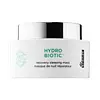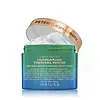What's inside
What's inside
 Key Ingredients
Key Ingredients

 Benefits
Benefits

 Concerns
Concerns

 Ingredients Side-by-side
Ingredients Side-by-side

Water
Skin ConditioningDimethicone
EmollientPropanediol
SolventGlycerin
HumectantSodium Chloride
MaskingDimethicone/PEG-10/15 Crosspolymer
Lactococcus Ferment Lysate
Skin ConditioningHexyldecanol
EmollientInulin
Skin Conditioning1,2-Hexanediol
Skin ConditioningSodium Benzoate
MaskingYogurt Powder
PEG-10 Dimethicone
Skin ConditioningButylene Glycol
HumectantTamarindus Indica Seed Polysaccharide
Skin ConditioningSodium Citrate
BufferingCaprylhydroxamic Acid
Tocopheryl Acetate
AntioxidantLavandula Angustifolia Oil
MaskingTrisodium Ethylenediamine Disuccinate
Bisabolol
MaskingCetylhydroxyproline Palmitamide
Skin ConditioningStearic Acid
CleansingHoney
HumectantBrassica Campestris Sterols
EmollientRosa Damascena Flower Oil
MaskingCamellia Sinensis Leaf Extract
AntimicrobialPhenoxyethanol
PreservativeVitis Vinifera Seed Extract
AntimicrobialBoswellia Serrata Extract
Skin ConditioningHoney Extract
HumectantChlorophyllin-Copper Complex
AntioxidantAspalathus Linearis Extract
Skin ConditioningSaccharomyces Polypeptides
Skin ConditioningWater, Dimethicone, Propanediol, Glycerin, Sodium Chloride, Dimethicone/PEG-10/15 Crosspolymer, Lactococcus Ferment Lysate, Hexyldecanol, Inulin, 1,2-Hexanediol, Sodium Benzoate, Yogurt Powder, PEG-10 Dimethicone, Butylene Glycol, Tamarindus Indica Seed Polysaccharide, Sodium Citrate, Caprylhydroxamic Acid, Tocopheryl Acetate, Lavandula Angustifolia Oil, Trisodium Ethylenediamine Disuccinate, Bisabolol, Cetylhydroxyproline Palmitamide, Stearic Acid, Honey, Brassica Campestris Sterols, Rosa Damascena Flower Oil, Camellia Sinensis Leaf Extract, Phenoxyethanol, Vitis Vinifera Seed Extract, Boswellia Serrata Extract, Honey Extract, Chlorophyllin-Copper Complex, Aspalathus Linearis Extract, Saccharomyces Polypeptides
Magnesium Sulfate
Butyrospermum Parkii Butter
Skin ConditioningButylene Glycol
HumectantDimethicone
EmollientShea Butter Glycerides
EmulsifyingCaprylic/Capric Triglyceride
MaskingCeteareth-20
CleansingKaolin
AbrasiveZeolite
AbsorbentHelianthus Annuus Seed Oil
EmollientPrunus Armeniaca Kernel Oil
MaskingPrunus Persica Kernel Oil
EmollientRosa Moschata Seed Oil
EmollientPrunus Amygdalus Dulcis Oil
Skin ConditioningSimmondsia Chinensis Seed Oil
EmollientGlycine Soja Oil
EmollientHoney
HumectantElaeis Guineensis Butter
EmollientPunica Granatum Fruit Juice
MaskingFagus Sylvatica Bud Extract
TonicSambucus Nigra Fruit Extract
AstringentRosmarinus Officinalis Leaf Extract
AntimicrobialTocopherol
AntioxidantGlycerin
HumectantIllite
AbrasiveSqualane
EmollientHydrogenated Vegetable Oil
EmollientLecithin
EmollientEthylhexyl Palmitate
EmollientDipropylene Glycol
HumectantDimethicone/PEG-10/15 Crosspolymer
Polysilicone-11
Lauryl PEG-9 Polydimethylsiloxyethyl Dimethicone
Skin ConditioningWater
Skin ConditioningEthoxydiglycol
HumectantPropylene Glycol
HumectantSodium Citrate
BufferingBenzyl Alcohol
PerfumingBenzoic Acid
MaskingSodium Benzoate
MaskingPotassium Sorbate
PreservativePhenoxyethanol
PreservativeMagnesium Sulfate, Butyrospermum Parkii Butter, Butylene Glycol, Dimethicone, Shea Butter Glycerides, Caprylic/Capric Triglyceride, Ceteareth-20, Kaolin, Zeolite, Helianthus Annuus Seed Oil, Prunus Armeniaca Kernel Oil, Prunus Persica Kernel Oil, Rosa Moschata Seed Oil, Prunus Amygdalus Dulcis Oil, Simmondsia Chinensis Seed Oil, Glycine Soja Oil, Honey, Elaeis Guineensis Butter, Punica Granatum Fruit Juice, Fagus Sylvatica Bud Extract, Sambucus Nigra Fruit Extract, Rosmarinus Officinalis Leaf Extract, Tocopherol, Glycerin, Illite, Squalane, Hydrogenated Vegetable Oil, Lecithin, Ethylhexyl Palmitate, Dipropylene Glycol, Dimethicone/PEG-10/15 Crosspolymer, Polysilicone-11, Lauryl PEG-9 Polydimethylsiloxyethyl Dimethicone, Water, Ethoxydiglycol, Propylene Glycol, Sodium Citrate, Benzyl Alcohol, Benzoic Acid, Sodium Benzoate, Potassium Sorbate, Phenoxyethanol
Ingredients Explained
These ingredients are found in both products.
Ingredients higher up in an ingredient list are typically present in a larger amount.
Butylene Glycol (or BG) is used within cosmetic products for a few different reasons:
Overall, Butylene Glycol is a safe and well-rounded ingredient that works well with other ingredients.
Though this ingredient works well with most skin types, some people with sensitive skin may experience a reaction such as allergic rashes, closed comedones, or itchiness.
Learn more about Butylene GlycolDimethicone is a type of synthetic silicone created from natural materials such as quartz.
What it does:
Dimethicone comes in different viscosities:
Depending on the viscosity, dimethicone has different properties.
Ingredients lists don't always show which type is used, so we recommend reaching out to the brand if you have questions about the viscosity.
This ingredient is unlikely to cause irritation because it does not get absorbed into skin. However, people with silicone allergies should be careful about using this ingredient.
Note: Dimethicone may contribute to pilling. This is because it is not oil or water soluble, so pilling may occur when layered with products. When mixed with heavy oils in a formula, the outcome is also quite greasy.
Learn more about DimethiconeDimethicone/PEG-10/15 Crosspolymer is a type of silicone.
Glycerin is already naturally found in your skin. It helps moisturize and protect your skin.
A study from 2016 found glycerin to be more effective as a humectant than AHAs and hyaluronic acid.
As a humectant, it helps the skin stay hydrated by pulling moisture to your skin. The low molecular weight of glycerin allows it to pull moisture into the deeper layers of your skin.
Hydrated skin improves your skin barrier; Your skin barrier helps protect against irritants and bacteria.
Glycerin has also been found to have antimicrobial and antiviral properties. Due to these properties, glycerin is often used in wound and burn treatments.
In cosmetics, glycerin is usually derived from plants such as soybean or palm. However, it can also be sourced from animals, such as tallow or animal fat.
This ingredient is organic, colorless, odorless, and non-toxic.
Glycerin is the name for this ingredient in American English. British English uses Glycerol/Glycerine.
Learn more about GlycerinHoney comes from bees. It is mainly made up of the sugars fructose and glucose.
Besides sugar, honey also contains amino acids, peptides, Vitamins A, C, and E. Vitamins A, C, and E.
As a humectant, honey is great at hydrating the skin. Humectants draw moisture from the air and hold it to your skin.
Honey also has antioxidant and antioxidant properties. Fun fact: darker honey has more antioxidants than light honey.
The antibacterial property of honey may make it effective at helping to treat acne. We recommend speaking with a professional if you have concerns.
Many people wonder if honey is vegan. It is technically a byproduct from bees. This is because honey is created from the digestive enzymes in a bee's stomach.
Remember to be kind to bees :) They are important for many ecosystems and are endangered.
Learn more about HoneyPhenoxyethanol is a preservative that has germicide, antimicrobial, and aromatic properties. Studies show that phenoxyethanol can prevent microbial growth. By itself, it has a scent that is similar to that of a rose.
It's often used in formulations along with Caprylyl Glycol to preserve the shelf life of products.
Sodium Benzoate is a preservative. It's used in both cosmetic and food products to inhibit the growth of mold and bacteria. It is typically produced synthetically.
Both the US FDA and EU Health Committee have approved the use of sodium benzoate. In the US, levels of 0.1% (of the total product) are allowed.
Sodium benzoate works as a preservative by inhibiting the growth of bacteria inside of cells. It prevents the cell from fermenting a type of sugar using an enzyme called phosphofructokinase.
It is the salt of benzoic acid. Foods containing sodium benzoate include soda, salad dressings, condiments, fruit juices, wines, and snack foods.
Studies for using ascorbic acid and sodium benzoate in cosmetics are lacking, especially in skincare routines with multiple steps.
We always recommend speaking with a professional, such as a dermatologist, if you have any concerns.
Learn more about Sodium BenzoateSodium Citrate is the sodium salts of citric acid. In skincare, it is used to alter pH levels and acts as a preservative.
Its main functions are to maintain the pH of a product and neutralize metal ions.
The acidity of our skin is maintained by our glands and skin biome; normal pH level of skin is slightly acidic (~4.75-5.5).
Being slightly acidic allows our skin to create an "acid mantle". This acid mantle is a thin barrier that protects our skin from bacteria and contaminants.
Learn more about Sodium CitrateWater. It's the most common cosmetic ingredient of all. You'll usually see it at the top of ingredient lists, meaning that it makes up the largest part of the product.
So why is it so popular? Water most often acts as a solvent - this means that it helps dissolve other ingredients into the formulation.
You'll also recognize water as that liquid we all need to stay alive. If you see this, drink a glass of water. Stay hydrated!
Learn more about Water